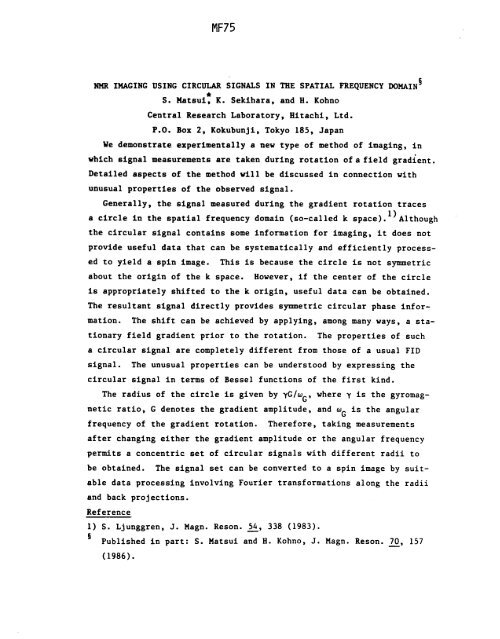th - 1987 - 51st ENC Conference
th - 1987 - 51st ENC Conference
th - 1987 - 51st ENC Conference
You also want an ePaper? Increase the reach of your titles
YUMPU automatically turns print PDFs into web optimized ePapers that Google loves.
MF75<br />
NMR IMAGING USING CIRCULAR SIGNALS IN THE SPATIAL FREQU<strong>ENC</strong>Y DOMAIN S<br />
S. Matsul, K. Seklhara, and H. Kohno<br />
Central Research Laboratory, Hitachi, Ltd.<br />
P.O. Box 2, Kokubunji, Tokyo 185, Japan<br />
We demonstrate experlmentally a new type of me<strong>th</strong>od of imaging, in<br />
which siena1 measurements are taken during rotation of a field gradient.<br />
Detailed aspects of <strong>th</strong>e me<strong>th</strong>od will be discussed in connection wi<strong>th</strong><br />
unusual properties of <strong>th</strong>e observed slgnal.<br />
Generally, <strong>th</strong>e slgnal measured during <strong>th</strong>e gradient rotation traces<br />
a circle in <strong>th</strong>e spatlal frequency domain (so-called k space). I) Al<strong>th</strong>ough<br />
<strong>th</strong>e clrcular signal contains some information for imaging, it does not<br />
provide useful data <strong>th</strong>at can be systematlcally and efficiently process-<br />
ed to yield a spin image. This is because <strong>th</strong>e circle is not symmetric<br />
about <strong>th</strong>e origin of <strong>th</strong>e k space. However, if <strong>th</strong>e center of <strong>th</strong>e clrcle<br />
is approprlately shifted to <strong>th</strong>e k origin, useful data can be obtained.<br />
The resultant signal directly provides symmetric circular phase infor-<br />
mation. The shift can be achieved by applying, amon E many ways, a sta-<br />
tionary fleld gradient prior to <strong>th</strong>e rotation. The properties of such<br />
a circular signal are completely different from <strong>th</strong>ose of a usual FID<br />
slgnal. The unusual properties can be understood by expressing <strong>th</strong>e<br />
clrcular signal in terms of Bessel functions of <strong>th</strong>e first kind.<br />
The radius of <strong>th</strong>e circle is given by 7G/WG, where Y is <strong>th</strong>e gyromag-<br />
netic ratio, G denotes <strong>th</strong>e gradient amplitude, and ~G is <strong>th</strong>e angular<br />
frequency of <strong>th</strong>e gradient rotation. Therefore, takin E measurements<br />
after changing ei<strong>th</strong>er <strong>th</strong>e gradient amplitude or <strong>th</strong>e angular frequency<br />
permits a concentric set of clrcular signals wi<strong>th</strong> different radii to<br />
be obtained. The signal set can be converted to a spin image by suit-<br />
able data processing involving Fourier transformations along <strong>th</strong>e radii<br />
and back projections.<br />
Reference<br />
I) S. Ljunggren, J. Magn. Reson. 54, 338 (1983).<br />
§ Published in part: S. Matsui and H. Kohno, J. Magn. Reson. 70, 157<br />
(1986).













